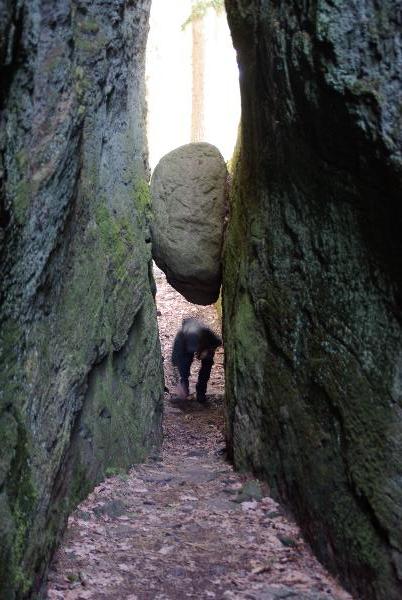
Borrås Skåra (Borrås Groove) is a 10 meters deep and 1-2 meters wide rock groove, formed by millennia of erosion and weathering.
Erosion:
Erosion is the process of weathering and transport of solids (sediment, soil, rock and other particles) in the natural environment or their source and deposits them elsewhere. It usually occurs due to transport by wind, water, or ice; by down-slope creep of soil and other material under the force of gravity; or by living organisms, such as burrowing animals, in the case of bioerosion.
Erosion is a natural process, but it has been increased dramatically by human land use, especially industrial agriculture, deforestation, and urban sprawl. Land that is used for industrial agriculture generally experiences a significant greater rate of erosion than that of land under natural vegetation, or land used for sustainable agricultural practices. This is particularly true if tillage is used, which reduces vegetation cover on the surface of the soil and disturbs both soil structure and plant roots that would otherwise hold the soil in place. However, improved land use practices can limit erosion, using techniques such as terrace-building, conservation tillage practices, and tree planting.
A certain amount of erosion is natural and, in fact, healthy for the ecosystem. For example, gravels continuously move downstream in watercourses. Excessive erosion, however, causes serious problems, such as receiving water sedimentation, ecosystem damage and outright loss of soil.
Erosion is distinguished from weathering, which is the process of chemical or physical breakdown of the minerals in the rocks, although the two processes may occur concurrently.
Weathering:
Weathering is the breaking down of Earth's rocks, soils and minerals through direct contact with the planet's atmosphere. Weathering occurs in situ, or "with no movement", and thus should not be confused with erosion, which involves the movement of rocks and minerals by agents such as water, ice, wind and gravity.
Weathering also is the effect of atmospheric exposure to man-made structures and materials.
Two important classifications of weathering processes exist — physical and chemical weathering. Mechanical or physical weathering involves the breakdown of rocks and soils through direct contact with atmospheric conditions, such as heat, water, ice and pressure. The second classification, chemical weathering, involves the direct effect of atmospheric chemicals or biologically produced chemicals (also known as biological weathering) in the breakdown of rocks, soils and minerals.
The materials left over after the rock breaks down combined with organic material creates soil. The mineral content of the soil is determined by the parent material, thus a soil derived from a single rock type can often be deficient in one or more minerals for good fertility, while a soil weathered from a mix of rock types (as in glacial, aeolian or alluvial sediments) often makes more fertile soil.
Source: Wikipedia
To obtain an approved log
Answer the following 4 questions and e-mail the answer to me::
1.The name on this Earth Cache
2.How much volume has the great stone that is stuck in the groove(send the calculation in the answer).
3. Of what type of rock is the great stone composed of?
4.Up at the highest point next to the groove is a small metal plate firmly riveted in the rock, what is the six-digit number on it?
